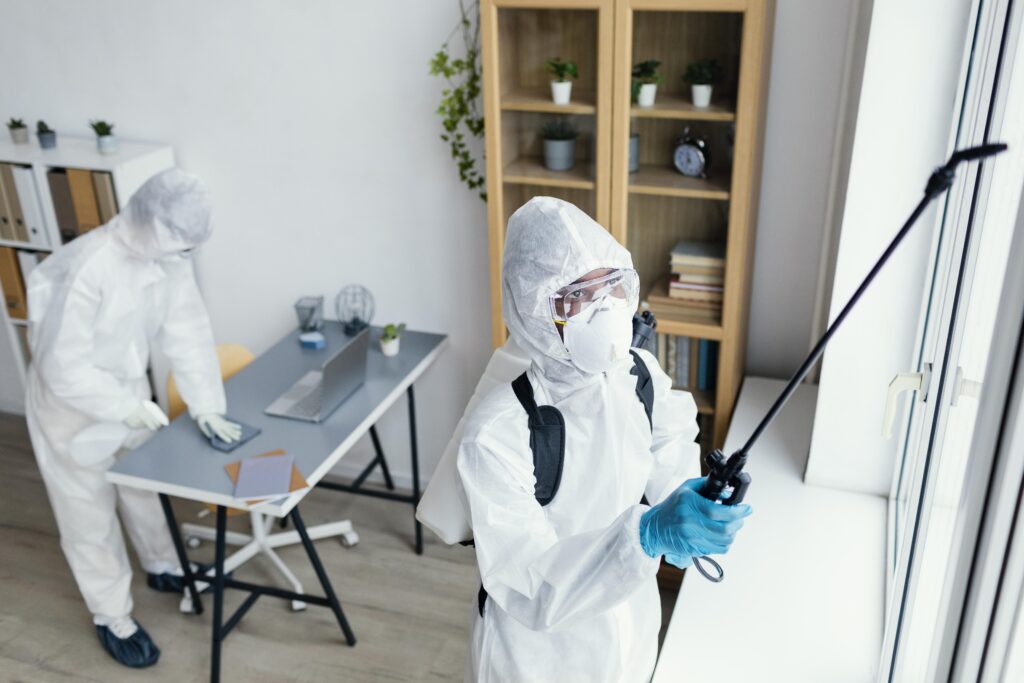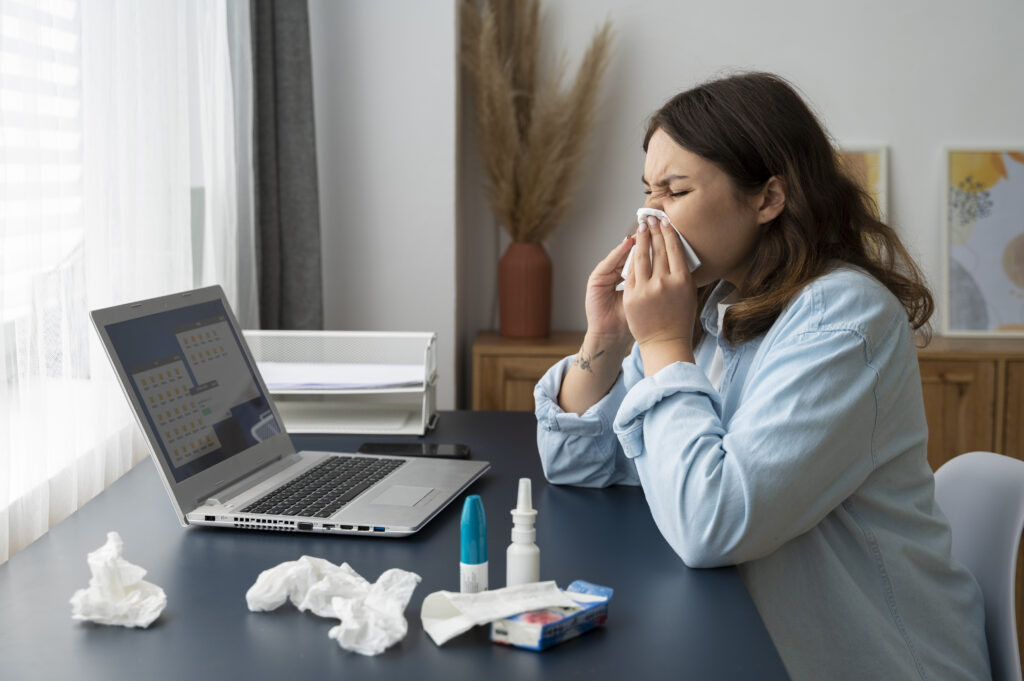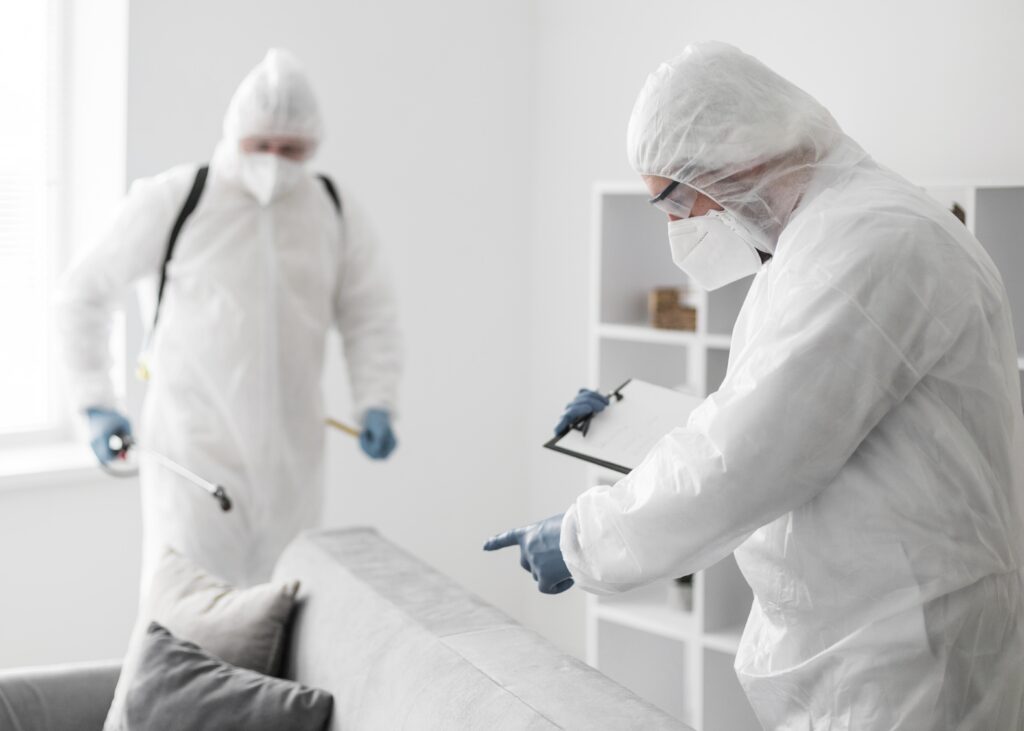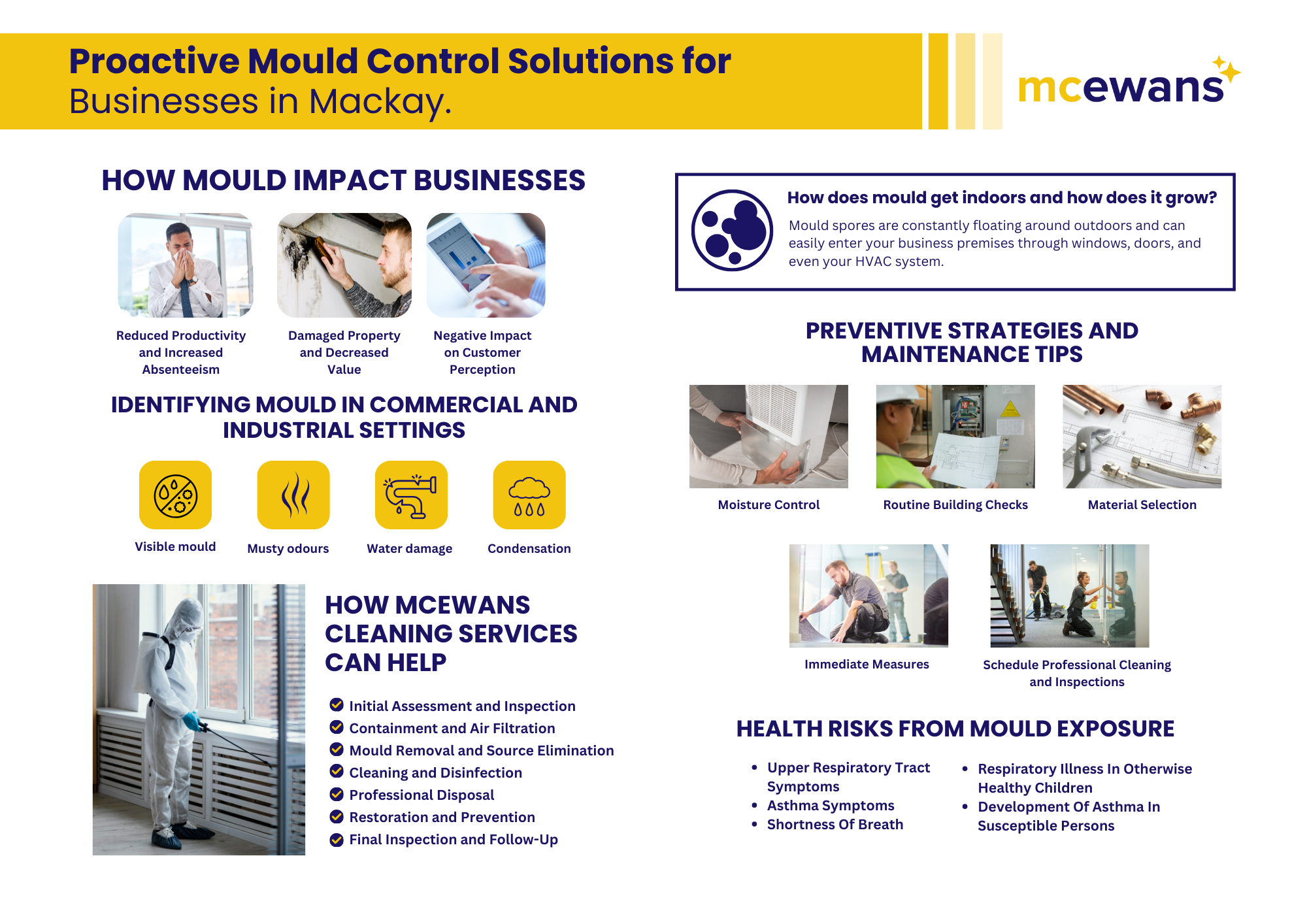Fun Fact:
Mould is always present around, and they have been on the Earth for millions of years.

The Center for Disease Control and Prevention (CDC) reveals that there is always some mould around, and that they have been present for millions of years. Mould spores can also float through the air, hitching a ride on everything from our clothes to our pets. Once inside, if they find a damp and cosy spot – like around leaky pipes, windows, or after a flood – they’ll happily set up shop and start growing on almost any surface imaginable.
In Mackay, Queensland, the arrival of autumn brings not just a change in the leaves, but also a heightened risk of mould growth within business premises. Due to specific climatic conditions, autumn mould risks in Australia are significantly higher compared to other seasons. This seasonal surge in mould can greatly affect both the health of those exposed to mould and the structural integrity of buildings.
At McEwans, we understand the challenges that mould growth presents for Mackay businesses. That’s why we offer comprehensive mould removal services to domestic and commercial spaces in Mackay keeping your premises healthy and productive. Our team of professionally trained experts is equipped with the latest technology and expertise to safely and effectively remove mould and prevent its return.
Recognising the critical impact of this issue, it is important to understand the nature of mould, its risks, and the most effective methods to tackle it. Let’s find out more about mould in commercial settings, equipping you with the knowledge to keep your Mackay business healthy and mould-free.
Understanding Mould and Its Impacts on Businesses
Mould is a form of fungus that thrives in moist environments and can proliferate rapidly under the right conditions, which are often met during Mackay’s humid autumn. Mackay experiences a tropical savanna climate, which means the autumn months often bring higher humidity levels. This sets as a prime example of the heightened autumn mould risks in Australia.
Mould thrives on common building materials like paper products, cardboard, ceiling tiles, and wood. In commercial settings, common types of indoor mould include Aspergillus, Cladosporium, and Penicillium, which not only degrade property but also pose serious health risks, according to CDC.
How does mould get indoors and how does it grow?
Mould spores are constantly floating around outdoors and can easily enter your business premises through windows, doors, and even your HVAC system. According to the National Center for Environmental Health, they thrive in damp environments, readily growing on various household materials like wood, paper products, and fabrics. Leaks, floods, and even potted plants can create these ideal moisture conditions, allowing mould to flourish indoors.
Health Risks from Mould Exposure

While some mould varieties play a beneficial role in the environment, those that find their way indoors can pose a significant health risk. Inhaling mould spores can trigger allergic reactions in people sensitive to them, causing symptoms like coughing, sneezing, itchy eyes, and irritated skin.
A report from the World Health Organisation (WHO) summarised by the CDC, reveals that exposure to mould and other dampness-related microbial agents increases the risks of rare conditions, such as hypersensitivity pneumonitis, allergic alveolitis, chronic rhinosinusitis and allergic fungal sinusitis.
Similarly, a study by the Institute of Medicine (IOM) found that there are health risks linked between indoor moulds and damp environment with sufficient evidence to inadequate information, including below:
- Upper Respiratory Tract (Nasal And Throat) Symptoms
- Coughing
- Asthma Symptoms In Sensitized Asthmatic Persons
- Shortness Of Breath
- Respiratory Illness In Otherwise Healthy Children
- Development Of Asthma In Susceptible Persons
How Moulds Impact Businesses
The presence of mould in your commercial space extends far beyond health concerns. Here’s how mould can negatively impact your business:
- Reduced Productivity and Increased Absenteeism
Employees exposed to mould may suffer from respiratory conditions, potentially leading to increased absenteeism and reduced productivity. A study by Harding et al., 2019 published in the National Library of Medicine found a link between mould exposure and decreased cognitive function and work performance,
Employees suffering from mould-related respiratory problems are also more likely to miss workdays, impacting overall productivity and efficiency.
- Damaged Property and Decreased Value
Mould growth can damage building materials like Gyprock, carpets, and furniture, leading to costly repairs and replacements. Furthermore, a property with a known mould problem can significantly decrease its market value, making it difficult to sell or lease.
- Negative Impact on Customer Perception
Did you know that 9/10 or 92% of consumers base their decision to return to a business on cleanliness?
Visible mould growth can create an unpleasant and unhealthy working environment for both employees and customers. This can damage your business’s reputation and deter potential customers from visiting your establishment.
By addressing mould problems promptly, you can protect your employees’ health, safeguard your property investment, and maintain a positive image for your business.
Identifying Mould in Commercial and Industrial Settings
The CDC mentions that mould growing in homes and buildings indicates that there is a problem with water or moisture. Identifying mould involves more than spotting black or green patches on walls or ceilings. According to the CDC, moulds can invade a wide range of indoor materials. While it commonly grows on paper products, cardboard, ceiling tiles, and wood, it can also find a foothold in dust, paints, wallpaper, insulation, drywall, carpet, fabric, and upholstery.
Here are some signs to watch for in your commercial or industrial space:
- Visible mould – Look for patches of black, green, or white discoloration on walls, ceilings, floors, furniture, or stored materials.
- Musty odours – A persistent musty smell can indicate mould growth, especially in areas with poor ventilation.
- Water damage – Mould often grows in areas with past or present water leaks or moisture problems.
- Condensation – Noticeable condensation on walls or windows is a sign of excess moisture, a prime condition for mould growth.
Common areas susceptible to mould growth include:
- Storage rooms
- Basements
- Bathrooms and locker rooms
- Areas around leaky pipes or windows
- Carpet and upholstery (especially in areas with high humidity)
In large spaces like warehouses or manufacturing facilities, mould can hide in less obvious places such as HVAC systems, under carpets, or in insulation materials. Key signs include a musty odour, visible mildew, or water stains—indicators that should prompt a thorough assessment of mould growth severity. Understanding where and how mould develops is critical in effectively managing its eradication.
Why Autumn in Mackay Is Critical for Mould Growth
Mackay’s autumn is marked by fluctuating temperatures and increased humidity, conditions that are ideal for mould growth. According to the Bureau of Meteorology, Mackay experienced an unusually warm autumn season in 2023, which had its equal-highest autumn mean daily maximum temperature on record. Meanwhile, widespread and extended flooding in Queensland occurred in early March, with record-breaking rainfall reported in the north-west.
These environmental factors, combined with frequent rain spells, can lead to moisture accumulation in buildings, further exacerbating mould issues. Proactive measures such as improving building insulation and enhancing air circulation can help mitigate these risks before the season fully sets in.
Here are some quick preventive steps you can take:
- Improve Building Insulation
- Enhance Air Circulation
- Address Leaks Promptly
- Maintain Low Indoor Humidity
- Schedule professional cleaning and inspections
Regular professional cleaning and inspections by a qualified company can help identify and address mould issues early on, preventing them from becoming a larger problem. Schedule an inspection with McEwans today for an early detection and intervention preventing mould from becoming a serious health hazard.
Mould Removal and Remediation Techniques

Mould remediation is a specialised process that involves cleaning visible growth and requires addressing the moisture source that allows mould to thrive. While minor mould issues can sometimes be managed in-house, commercial mould remediation for Queensland businesses is recommended for larger infestations to ensure that mould is thoroughly removed and that it does not return.
The process typically includes the following steps:
- Initial Assessment
Experts conduct a thorough inspection to determine the extent and location of mould growth.
- Containment
To prevent the spread of mould spores, the affected area is isolated using physical barriers and negative air pressure.
- Filtration
Air scrubbers and HEPA filters are used to purify the air of mould spores and other particulates.
McEwans utilises state-of-the-art vacuums for effective commercial mould remediation in Mackay.These powerful vacuums not only remove mould spores effectively but also contribute significantly to improving indoor air quality by eliminating other airborne particulates.
- Removal and Cleaning
Infected materials are removed or cleaned using antimicrobial treatments and specialised cleaning solutions.
- Drying
The area is dried to ensure that no residual moisture remains that could encourage further mould growth.
- Restoration
Any damaged materials are repaired or replaced to restore the area to its original condition.
DIY vs. Professional Mould Removal: When to Call in the Experts
According to the CDC, standards for judging what is an acceptable, tolerable or normal quantity of mould have not been established. But, the best practice is always to remove the mould right away and work to prevent future growth.
While small mould outbreaks can sometimes be managed with DIY efforts, professional remediation is crucial under certain conditions, particularly when it comes to effective mould removal in Mackay.
- Extensive Mould Growth
Large areas of mould require professional techniques and equipment to fully eradicate.
- HVAC Contamination
If mould infiltrates an HVAC system, professionals are needed to prevent widespread distribution throughout the property.
- Health Risks
Individuals with allergies, asthma, or weakened immune systems should avoid exposure to mould. If you or your employees experience unexplained respiratory issues or allergic reactions while at work, mould exposure might be a contributing factor.
Consulting a professional for a thorough inspection is highly recommended. Professionals can safely handle removal without risking health, especially in cases requiring commercial mould remediation in Queensland, where expert knowledge and equipment are crucial for effective treatment.
Safety Measures and Equipment Used in the Mould Removal Process
Safety is a priority in mould remediation to protect both the workers and the building occupants. Essential safety measures and equipment include:
- Personal Protective Equipment (PPE) -This includes gloves, goggles, and N95 respirator masks to protect against inhaling or touching mould spores.
- HEPA Vacuums – Used to clean up dust and small particles that contain mould spores, ensuring they are fully removed from the premises.
- Air Scrubbers – These devices filter and clean the air of impurities, including mould spores, thus maintaining a safe air quality during and after the remediation process.
By following these structured techniques and safety protocols, professionals can effectively manage and eradicate mould, safeguarding the structural integrity of buildings and the health of their occupants.
Preventive Strategies and Maintenance Tips

Long-term prevention of mould in commercial settings involves regular maintenance and vigilance. This includes scheduling routine inspections, maintaining optimal humidity levels (ideally between 30% and 50%), and ensuring effective ventilation.
Other preventative measures such as using mould-resistant materials in construction and regularly cleaning HVAC systems can also be significant in reducing autumn mould risks in Australia.
Long-term Strategies for Preventing Mould in Commercial and Industrial Environments
Implementing long-term strategies for industrial mould prevention services is crucial for maintaining a healthy industrial workplace. According to the Environmental Protection Agency (EPA), controlling moisture levels is the most effective way of keeping mould from growing as well as repairing leaks immediately. Key strategies include:
- Moisture Control
Installing dehumidifiers in areas prone to high humidity can help maintain moisture levels below the 60% threshold commonly recommended for mould prevention.
- Routine Building Checks
Regularly inspecting roofing, plumbing, and HVAC systems to ensure they are not sources of water intrusion. The EPA recommends to ensure ducts are properly sealed and insulated in all non-air-conditioned spaces so moisture due to condensation does not enter the system.
- Material Selection
Using mould-resistant materials during construction or renovation, such as mould-resistant drywall or paints, can significantly reduce the risk of mould development.
- Immediate Measures
The EPA also advises that carpets, drapes, furniture, and other furnishings are dried promptly after they have been cleaned.
- Schedule Professional Cleaning and Inspections
Regular professional cleaning and detailed inspections are key to maintaining a mould-free environment.
McEwans Mould Removal services in Mackay offer comprehensive cleaning and expert inspections to ensure that all potential mould growth is identified and addressed promptly, keeping your commercial or industrial spaces safe and healthy.
How McEwans Cleaning Services Can Help
In Mackay, businesses face unique challenges with the humid tropical climate, especially during the autumn months when moisture levels can significantly increase, raising the risks of mould growth. McEwans Cleaning Services is well-equipped to tackle these challenges head-on with specialised mould removal services tailored to the local environment.
Our Mould Removal Mackay service provides expert commercial mould remediation throughout Queensland, ensuring that your business is not only free of current mould issues but also safeguarded against future outbreaks. Our expert services include:
- Initial Assessment and Inspection
- Containment and Air Filtration
- Mould Removal and Source Elimination
- Mould Spot Cleaning (Domestic & Commercial)
- Fogging (Domestic & Commercial)
- Cleaning and Disinfection
- Proper Disposal
- Restoration and Prevention
- Final Inspection and Follow-Up
With the onset of the fall season and the associated autumn mould risks in Australia, our team offers timely interventions to prevent mould from affecting the health of your workplace and the integrity of your building.
For businesses in Mackay looking to mitigate autumn mould risks in Australia, McEwans offers a robust solution to maintain high standards of cleanliness. Contact us today to learn more about how we can keep your commercial or industrial space mould-free and operating smoothly.
Conclusion
Maintaining a mould-free environment in Mackay, especially during the risky autumn season, requires a proactive and informed approach. By understanding the nature and risks of mould and implementing effective strategies and maintenance routines, businesses can safeguard their premises, protect their employees’ health, and uphold their reputation.
McEwans Mould Removal Services plays an important role in this effort by offering tailored and expert mould remediation solutions that address both current infestations and prevent future occurrences.
Key Takeaways:
- Understand the Risks – Recognize the health and structural dangers posed by mould in commercial and industrial settings.
- Proactive Measures – Implement long-term prevention strategies such as maintaining low humidity levels and ensuring effective ventilation.
- Seasonal Awareness – Pay extra attention during autumn, when the conditions in Mackay are most conducive to mould growth.
- Expert Intervention – Utilise professional mould removal services like McEwans for comprehensive and effective mould remediation.
- Regular Maintenance – Schedule routine professional inspections and cleaning to catch and address mould growth early.
Regular professional cleaning and inspections can help identify early warning signs of mould growth. Our trained professionals at McEwans can assess your building’s specific vulnerabilities and recommend preventive measures to create a long-lasting solution for a healthy work environment. Schedule an inspection with McEwans today!
Call or visit: 1800 979 737 | https://mcewanscleaning.com.au/contact.


